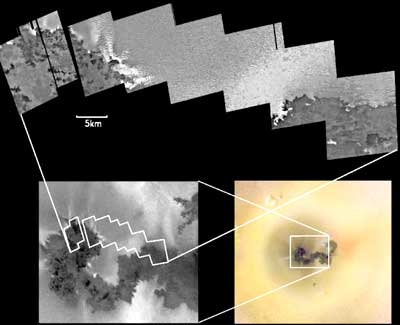
Sulfur-rich 'snow' found on Jupiter's volcanic moon Io
NASA/JPL NEWS RELEASE
Posted: October 30, 2000
New pictures of the most volcanically active world in our solar system show it also has surface activity that resembles the accumulation and disappearance of bright snow or ice.
The images from NASA's Galileo spacecraft include the
highest-resolution view yet of Io, one of Jupiter's large moons.
A bumpy plain in that image has dark and light patches
interspersed like dark rocks reappearing through a shrinking
layer of springtime snow. Elsewhere on Io, plains appear fully
blanketed by the snow-like material.

The area, called Amirani, has been known to be the home of a number of volcanic hot spots ever since NASA's two Voyager spacecraft flew by Jupiter in 1979. Images collected by Galileo in 1999 showed that these hot areas were part of a single immense lava flow field. The newest images confirm that the Amirani flow field is indeed a quilt work of dark lava flows. The most recent lavas are darkest because they are too hot to be covered by sulfur-dioxide plumes. Fresh lava is leaking out of at least five areas at the northern end of the Amirani flow field and at least three places in the middle. However, it is likely that the lava first comes to the surface near the southern end of the flow field. The liquid lava travels under a frozen layer of older lava, breaking out onto the surface on ly after traveling hundreds of kilometers (hundreds of miles) from the vent. While the behavior of the lava once it is on the surface makes sense, how it comes to the surface is more complicated. Small, white, diffuse halos surrounding the darkest lava flows are probably sulfur-dioxide-rich snows and frosts that have been vaporized by the hot lava. The bright red material to the south of the Amirani flow field is likely to contain a large fraction of sulfur droplets. Sulfur-rich gas appears to be bubbling out all along the east-west crack at the southern end of Amirani. This may be the crack along which the lava rises to the surface. The main Amirani plume appears to emanate from a fuzzy, purplish area within the southern part of the flow field. This is a plausible alternative location for the lava to come to the surface. Photo: NASA/JPL
|
It's not frozen water like Earth's snow, but a sulfur-rich material that looks like white snow, said Dr. Alfred McEwen, a planetary scientist at the University of Arizona, Tucson. In some of Io's active volcanic plumes, the volatile material apparently even falls to the ground as frozen particles or crystals, like snowflakes.
"We see this volatile material everywhere on Io where we've
had a close-up look," McEwen said. It includes sulfur dioxide and
probably other sulfur-rich substances, he said. On Earth, sulfur
dioxide is a gas. On Io, it can be either a solid or a gas at the
surface or a subsurface liquid.
The textures on Io's plains suggest that some material that had
been solid has dissipated by sublimating from a solid to a gas.
"It looks like this volatile material is sublimating or eroding
away by some means, yet it's still there," McEwen said. "We'd
like to know where it's coming from, how the surface layer is
being resupplied."
New images also add evidence that many bowl-shaped
depressions in volcanic areas may be linked to fracturing and
shifting of Io's crust, not just to collapses above underground
magma chambers, like the large volcanic craters called calderas
on Earth.

This composite of images from Galileo contains three views at three different image resolutions of the volcano Prometheus on Jupiter's moon Io. The upper mosaic consists of eight high-resolution frames (12 meters or 39 feet per picture element). The lower left image is a single medium-resolution frame (170 meters or 186 yards per picture element); and the lower right mosaic consists of several low-resolution color frames (1.3 kilometers or .81 miles per picture element). At increasing resolution, more surface details about Prometheus become clear. For example, dark spots visible on flows of Prometheus at lower resolution resolve into dark, fresh lava flows with well-defined margins at higher resolution. Bright spots along the margins of Prometheus resolve into bright streaks that appear to come from plumes emanating from the edges of the Prometheus flows. The terrain surrounding Prometheus, which appears relatively smooth at lower resolution, resolves into a complex material composed of rough, ridge-like features at high er resolution. Also visible in the rightmost frame of the high-resolution mosaic (on the northern edge of the very dark lava flow in the lower right corner) are two bright spots, which may indicate active, glowing lava breakouts. Photo: NASA/JPL
|

|
 |
 |
 |




|

